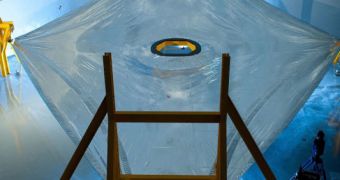In 2018, the American space agency plans to launch the next-generation James Webb Space Telescope (JWST). Over the past year or so, things have begun moving along efficiently, as demonstrated by a new, successful test conducted on the large observatory's massive sunshield.
This component is of critical importance because the JWST will survey the Universe in infrared wavelengths. This means that it will only be able to see objects that are warmer than it is. By cooling it down to extreme temperatures, engineers ensure that they can see most objects out there.
But cooling a foldable telescope the size of this one is not an easy task. In addition to the active cooling systems, the satellite also has to prevent sunlight from heating it directly, or from entering its extremely sensitive detectors.
This is where the sunshield comes in. The component is about the size of a tennis court, and is made up of five identical layers. Its job is to always remain oriented towards the Sun, and absorb all light and heat that would otherwise hit the body of the telescope.
During the recent test, engineers at main contractor Northrop Grumman Corporation (NGC) stretched the preflight layers of the sunshield into their final configuration, both in a normal position and upside down. They then used lasers and radar instruments to create 3D models of each layer.
The goal here was to determine whether the actual sunshield would look precisely like they do in the telescope's schematics. As the most complex spacecraft ever to be built, the JWST project has little to no room for errors.
“The as-built and measured membrane was within .36 inches Root-Mean-Squared of the 3-D shape the model predicted, over an area as large as a tennis court, which is remarkable,” official Jim Flynn says.
“Our teammate, ManTech International, has done an outstanding job in sunshield fabrication and test. This result validates our ability to manufacture the sunshield layers to meet extremely demanding performance standards,” he adds.
Flynn holds an appointment as the JWST sunshield manager at Northrop Grumman Aerospace Systems, the NGC division in charge of manufacturing, testing and delivering the sunshield to the NASA Goddard Space Flight Center (GSFC), in Greenbelt, Maryland.
The effort to build the sunshield is made even more complex by the fact that each of the 5 layers is as thin as a human hair and has a slightly different shape from all the others.

 14 DAY TRIAL //
14 DAY TRIAL //